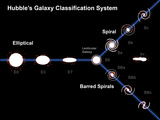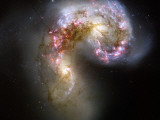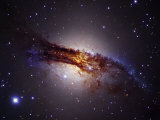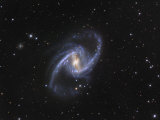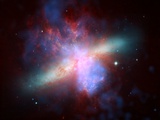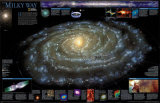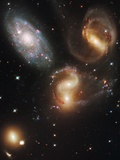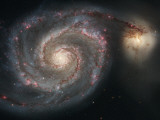|
|
Galaxy Educational Astronomy Posters
for the social studies and science classrooms, and home schoolers.
|
science > astronomy > GALAXIES < astronomy glossary
|
|
Galaxies are large gravitationally bound systems of stars, interstellar gas and dust, plasma and unseen dark matter.
The Universe contains millions of galaxies. The word “galaxy” is from the Greek term for “milky circle”, and refers to the band of bright stars they saw in the night sky.
FYI ~ In Greek mythology Zeus placied his son Heracles, born by a mortal woman, on Hera's breast while she is asleep so that the baby will drink her divine milk and become immortal. When Hera wakes up and realizes she is nursing an unknown baby, she pulls away and a jet of her milk sprays the night sky, producing the faint band of light.
|
|
|
The Local Group is a group of more than 54 galaxies, including dwarf galaxies, with its gravitational center, the Galactic Center, located somewhere between the Milky Way and the Andromeda Galaxy, at a radio source named Sagittarius A*; the third largest galaxy is Triangulum. The group itself is part of the Virgo Supercluster.
Poster Text: The Milky Way and its neighbors as seen from a location about 700,000 light years from the Sun. The nearest galaxies are the two irregular dwarves, the Magellanic Clouds. In the distance beyound them is the spiral galaxy, M33. There are about 30 members of the Local Group, but not all show up in this perspective. The location of our Sun is marked by a red dot. ...
|
|
|
|
The Hubble sequence is a morphological classification scheme dividing galaxies into groups based on their visual appearance.
There are three main types of galaxies- ellipticals, spirals and irregulars; galaxies that do not fit into Hubble's scheme are called irregular galaxies.
The Hubble system was devised by Edwin Hubble in 1926 and later expanded by Gérard de Vaucouleurs and Allan Sandage. The system is subjective meaning different observers may assign the same galaxy to different classes based on their opinion.
|
|
|
|
Andromeda (Messier 31, M31, or NGC 224) a spiral galaxy approximately 2.6 million light-years from Earth, is the nearest spiral galaxy to our Milky Way Galaxy, but not the closest galaxy overall.
Galaxy collision is common and the Andromeda Galaxy and the Milky Way are expected to eventually meet. If the galaxies do not merge, there is a small chance that the Solar System could be ejected from the Milky Way or join M31 ... in about 4.5 billion years.
In Greek mythology Andromeda is a princess, the daughter of Cepheus and Cassiopeia, king and queen of the kingdom Ethiopia, and eventually the wife of Perseus and the ancestor of the Persians.
|
|
|
|
The Antenna Galaxies are a pair of galaxies undergoing a violent collision some 90 million light years away toward the constellation Corvus.
They are known as the ‘Antenna Galaxies’ because two long tails of stars, gas, and dust thrown out of the galaxies as a result of the collision resemble the antennae of an insect. Most galaxies probably undergo at least one significant collision in their lifetime.
|
|
|
|
The Antenna Galaxies are a pair of galaxies undergoing a violent collision some 90 million light years away toward the constellation Corvus.
They are known as the ‘Antenna Galaxies’ because two long tails of stars, gas, and dust thrown out of the galaxies as a result of the collision resemble the antennae of an insect. Most galaxies probably undergo at least one significant collision in their lifetime.
|
|
|
|
Centaurus A (NGC 5128), in the constellation Centaurus, is a star-burst galaxy, or a galaxy in the process of star formation, due to a collision with a spiral galaxy. Centaurus A is about 14 million light-years away and appears as a disk (lenticular) with a dark band.
Though is is one of the closest galaxies to Earth it s only visible from low northern latitudes and the southern hemisphere. Centaurus A peculiarity's were first identified by John Herschel, (son and nephew of Caroline and William Herschel), in 1847.
Did you know that the initials NGC stands for New General Catalogue, an index of nearly 8,000 deep sky objects?
|
|
|
|
Great Barred Spiral Galaxy, NGC 1365, is located in the Fornax Consellation.
The description bar is for a central bar-shaped structure composed of stars.
|
|
|
|
Cartwheel Galaxy, also known as ESO 350-40, is a lenticular galaxy about 500 million light-years away in the constellation Sculptor.
The unusual shape of the Cartwheel Galaxy may be due to a collision with a smaller galaxy. It was discovered in 1941 by Fritz Zwicky.
|
|
|
|
Cigar Galaxy, M82, is a nearby starburst galaxy in the constellation Ursa Major.
At the galaxy's center young stars are being born 10 times faster than they are inside our entire Milky Way Galaxy.
|
|
|
|
Our planet Earth and Solar System are part of the Milky Way Galaxy, a barred spiral galaxy about 100,000 light years in diameter and 3,000 light years in thickness, containing 3x1011 stars.
The Milky Way is estimated to be about 13.2 billion years old, nearly as old as the Universe. The Milky Way and the Andromeda Galaxies are part of the Local Group of galaxies that also includes the Large Magellanic Cloud and the Triangulum Galaxy.
The bright band on the dark night sky has been observed for millenia but it wasn't until 1610 that Galileo Galilei used a telescope to confirm that the Milky Way was made up of faint stars.
FYI ~ The Milky Way does not have a Messier number. Why? Because we are in the Milky Way Galaxy and it does not appear as an object in our sky.
|
|
|
|
You Are Here- Milky Way Galaxy
Carl Sagan quote from a public lecture delivered October 13, 1994 - "Look at that dot. That’s here. That’s home. That’s us. On it everyone you love, everyone you know, everyone you ever heard of, every human being who ever was, lived out their lives. The aggregate of our joy and suffering, thousands of confident religions, ideologies, and economic doctrines, every hunter and forager, every hero and coward, every creator and destroyer of civilization, every king and peasant, every young couple in love, every mother and father, hopeful child, inventor and explorer, every teacher of morals, every corrupt politician, every ’superstar,’ every ’supreme leader,’ every saint and sinner in the history of our species lived there – on a mote of dust suspended in a sunbeam.
The earth is a very small stage in a vast cosmic arena. Think of the rivers of blood spilled by all those generals, so that, in glory and triumph, they could become the momentary masters of a fraction of a dot. Think of the endless cruelties visited by the inhabitants of one corner of this pixel on the scarcely distinguishable inhabitants of some other corner, how frequent their misunderstandings, how eager they are to kill one another, how fervent their hatreds. Our posturings, our imagined self-importance, the delusion that we have some privileged position in the universe, are challenged by this point of pale light.
Our planet is a lonely speck in the great enveloping cosmic dark. In our obscurity, in all this vastness, there is no hint that help will come from elsewhere to save us from ourselves.
The earth is the only world so far to harbor life. There is nowhere else, at least in the near future, to which our species could migrate. Visit, yes, settle, not yet. Like it or not, for the moment the Earth is where we make our stand.
It has been said that astronomy is a humbling and character-building experience. There is perhaps better no better demonstration of the folly of human conceits than this distant image of our tiny world. It underscores our responsibility to deal more kindly with one another, to preserve and cherish the pale blue dot, the only home we’ve ever known.
• Carl Sagan's Cosmic Calendar
• more Stars Charts posters
|
|
|
|
Pinwheel, Messier 101 or NGC 5457, is a “face-on” spiral galaxy distanced 21 million light-years away from Earth in the constellation Ursa Major.
M101 is a relatively large galaxy compared to the Milky Way. With a diameter of 170,000 light-years it is seventy percent larger than the Milky Way. It has a disk mass on the order of 100 billion solar masses, along with a small bulge of about 3 billion solar masses.
It was first discovered by Pierre Méchain on March 27, 1781, and communicated to Charles Messier who verified its position for inclusion in the Messier Catalogue as one of its final entries.
|
|
|
|
NGC 4414 is an unbarred spiral galaxy about 62 million light-years away in the constellation Coma Berenices. The outer arms appear blue due to the continuing formation of young stars.
It is a flocculent galaxy, with short segments of spiral structure but without the dramatic well-defined spiral arms of a grand design spiral. In 1974 a supernova, SN 1974G, was observed and is the only supernova in this galaxy to be recorded so far.
It was imaged by the Hubble Space Telescope in 1995, as part of the HST's main mission to determine the distance to galaxies, and again in 1999 as part of the Hubble Heritage project.
|
|
|
|
The Sombrero Spiral Galaxy, so named because it resembles the broad-brimmed Mexican hat, is one of the most famous objects in the sky. Seen edge on, the light from billions of old, faint stars form the vast “bulge” around a tiny, hidden nucleus. It is over 60 million light years away from Earth.
The Sombrero Galaxy was discovered in March 1767 by Pierre Méchain, Charles Messier made a hand-written note about this and five other objects (now collectively recognized as M104 - M109) to his personal list of objects now known as the Messier Catalogue, and William Herschel independently discovered the object in 1784.
|
|
|
|
Stephan's Quintet, in the constellation Pegasus, is a visual grouping of five galaxies of which four form the first compact galaxy group ever discovered. They are numbered NGC 7317–7320. The 5th, NGC 7320 is roughly 40 million light years closer to Earth and is not part of the compact group of four.
The group was discovered by Édouard Stephan in 1877 at Marseilles Observatory and is the most studied of all the compact galaxy groups.
|
|
|
|
The Tadpole Galaxy, UGC 10214, is a spiral galaxy that has been violently disrupted by a collision with a smaller companion galaxy, the compact, blue object in the upper left corner of the much more massive Tadpole galaxy.
Strong gravitational forces from the interaction between the galaxies created the long tail of debris, which is made up of stars and gas that stretch out more than 280,000 light years. Hundreds of blue stars and star clusters are visible in the spiral arms of the galaxy and in the tidal debris tail. The galaxy is backdropped by thousands of faint background galaxies.
The Tadpole Galaxy is located some 420 million light years away toward the constellation Draco.
|
|
|
|
The Triangulum Galaxy is a spiral galaxy approximately 3 million light years from Earth in the constellation Triangulum. It is the third largest member of the Local Group, a group of galaxies which also contains the Milky Way Galaxy and the Andromeda Galaxy.
The Triangulum Galaxy was probably discovered by the Italian astronomer Giovanni Battista Hodierna before 1654 and independently discovered by Charles Messier on the night of August 25–26, 1764. It was published in his Catalog of Nebulae and Star Clusters (1771) as object number 33; hence the name M33.
|
|
|
|
The Whirlpool Galaxy, aka M51 or NGC 5194, “is an interacting grand-design spiral galaxy that is estimated to be 23 ± 4 million light-years from the Milky Way Galaxy in the constellation Canes Venatici”.
It is one of the most famous galaxies in the sky and its companion (NGC 5195) are easily observed by amateur astronomers with binoculars.
|
|
|
previous page | top
|
|
I have searched the web for visual, text, and manipulative curriculum support materials - teaching posters, art prints, maps, charts, calendars, books and educational toys featuring famous people, places and events - to help teachers optimize their valuable time and budget.
Browsing the subject areas at NetPosterWorks.com is a learning experience where educators can plan context rich environments while comparing prices, special discounts, framing options and shipping from educational resources.
Thank you for starting your search for inspirational, motivational, and educational posters and learning materials at NetPosterWorks.com. If you need help please contact us.
|
|
|












